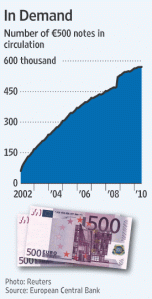Gangsters, drug dealers and money launderers appear to be playing their part in helping shore up the financial stability of the euro zone. That’s thanks to their demand, according to European authorities, for high-denomination euro bank notes, in particular the €200 and €500 bills. The European Central Bank issues these notes for a hefty profit that is welcome at a time when its response to the financial crisis has called its financial strength into question.
The high-value bills are increasingly “making the euro the currency of choice for underground and black economies, and for all those who value anonymity in their financial transactions and investments,” wrote Willem Buiter, chief economist at Citigroup, in a recent research report. The business of issuing euro notes, produced at almost zero cost, is “wildly profitable” for the ECB, Mr. Buiter wrote.
When euro notes and coins went into circulation in January 2002, the value of €500 notes outstanding was €30.8 billion ($40 billion), according to the ECB.
Today some €285 billion worth of euro notes are in existence, an annual growth rate of 32%. By value, 35% of euro notes in circulation are in the highest denomination, the €500 bill that few people ever see.
 In 1998, then-U.S. Treasury official Gary Gensler worried publicly about the competition to the $100 bill, the biggest U.S. bank note, posed by the big euro notes and their likely use by criminals. He pointed out that $1 million in $100 bills weighs 22 pounds; in hypothetical $500 bills, it would weigh just 4.4 pounds.
In 1998, then-U.S. Treasury official Gary Gensler worried publicly about the competition to the $100 bill, the biggest U.S. bank note, posed by the big euro notes and their likely use by criminals. He pointed out that $1 million in $100 bills weighs 22 pounds; in hypothetical $500 bills, it would weigh just 4.4 pounds.
Police forces have found the big euro notes in cereal boxes, tires and in hidden compartments in trucks, says Soren Pedersen, spokesman for Europol, the European police agency based in The Hague. “Needless to say, this cash is often linked to the illegal drugs trade, which explains the similarity in methods of concealment that are used.”
A spokeswoman for the ECB declined to comment on who uses the bills.
The ECB and its member governments are beneficiaries of the demand.
The profit a central bank gains from issuing currency—as well as from other privileges of a central bank, such as being able to demand no-cost or low-cost deposits from banks—is known as seigniorage. It normally accrues to national treasuries once the central banks account for their own costs.
The ECB’s gains from seigniorage are becoming increasingly important this year.
The ECB has taken hundreds of billions of euros of assets of unknown quality on to its balance sheet as it has reacted to the global financial crisis.
It holds more than €600 billion in collateral from banks to which it has made loans, and more than €400 billion in securities it holds outright, including government bonds.
Overall, the ECB’s balance sheet has grown to almost €2 trillion. It has a capital base of €78 billion. That creates leverage that makes it look like a “hedge fund on steroids,” Mr. Buiter wrote. It wouldn’t need to lose much on these assets to wipe out its thin cushion of capital.
That’s where seigniorage comes in.
In recent years, the profits on its issue of new paper currency have been running at €50 billion. In 2008, the year of the Lehman Brothers crisis, it was €80 billion.
Even with conservative assumptions about future growth of currency in circulation—at, say, 4% a year, which is in line with the ECB’s 2% inflation target plus a margin for economic growth—Mr. Buiter estimates future seigniorage profits for the central bank between €2 trillion and €6.9 trillion.
Thanks to seigniorage, he says, the ECB is “super solvent.”
An ECB spokeswoman says there’s no plan to withdraw high-value notes, national equivalents of which were used in six member states before the euro was launched. They will be retained when a redesigned series is issued in coming years.
Replacing them with small denominations would increase production and processing costs, she says.






No comments:
Post a Comment